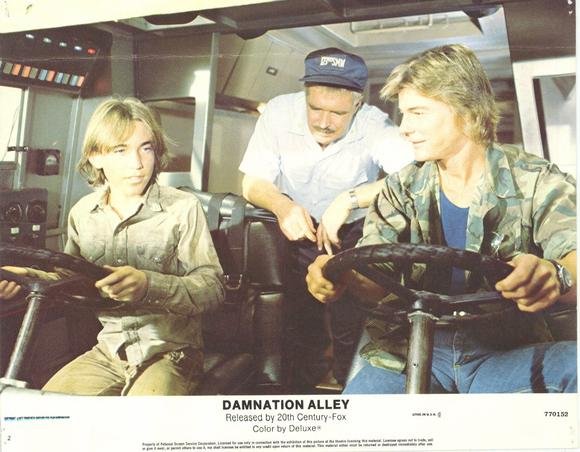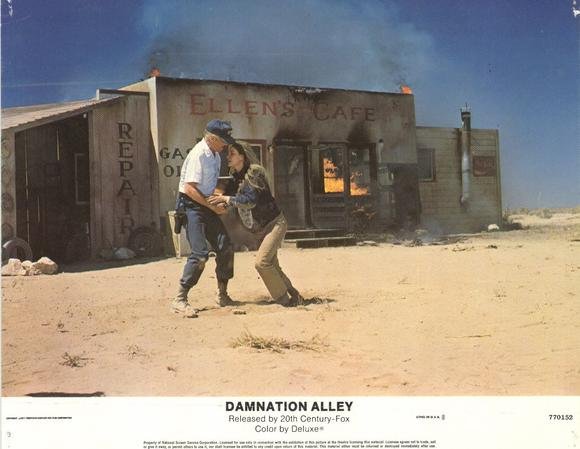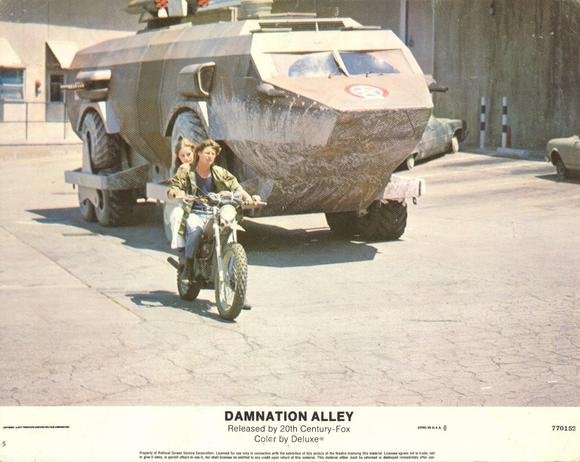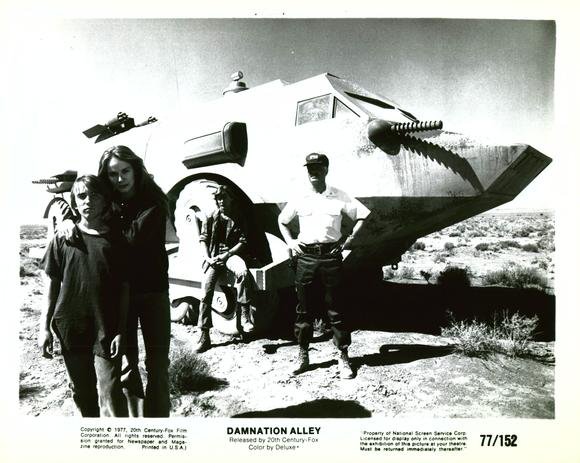DAMNATION ALLEY: The Post-Apocalyptic Genre Meets Its Apocalypse
Some movies are more interesting for what they represent than their actual artistic worth - and that can definitely be said for Damnation Alley. This big-budget adaptation of a cult fave novel by Roger Zelazny came out the same year as Star Wars - 1977 - and it represents the dying gasp of 1970's-style dystopian science fiction (think the Planet Of The Apes movies, No Blade Of Grass, The Ultimate Warrior, etc.). It also serves as an object lesson on how Hollywood could also misunderstand their source material as they tried to turn it into a marketable product. The Zelazny novel was kind of like a hard-boiled pulp take on sci-fi, with a biker named Hell Tanner getting sprung from prison by the government in a post-nuclear war America so he could participate in a dangerous mission to get medicine across a desolate stretch of nuke-ravaged countryside. The original script supposedly stayed close to this narrative but it underwent some fairly radical changes in the development process. What ultimately ended up on screen was a kind of greatest-hits redux of 1970's dystopian/post-apocalypse Hollywood sci-fi with an odd, downright quixotic "optimistic" bent.
The Zelazny novel was kind of like a hard-boiled pulp take on sci-fi, with a biker named Hell Tanner getting sprung from prison by the government in a post-nuclear war America so he could participate in a dangerous mission to get medicine across a desolate stretch of nuke-ravaged countryside. The original script supposedly stayed close to this narrative but it underwent some fairly radical changes in the development process. What ultimately ended up on screen was a kind of greatest-hits redux of 1970's dystopian/post-apocalypse Hollywood sci-fi with an odd, downright quixotic "optimistic" bent. In the film version of Damnation Alley, all that remains is the basic concept of a journey across nuke-ravaged America and a character named Tanner (played by Jan-Michael Vincent). Tanner has become an army man who works with Major "Sam" Denton (George Peppard) and airmen Keegan (Paul Winfield) and Perry (Kip Niven). Tanner and Denton butt heads over their approaches to military life: Tanner is a free spirit and Denton is a by-the-book man. However, this means little when the U.S. suffers a nuclear attack and both men are forced to initiate a retaliatory missle launch. With their actions, the world as we know it comes to an end.
In the film version of Damnation Alley, all that remains is the basic concept of a journey across nuke-ravaged America and a character named Tanner (played by Jan-Michael Vincent). Tanner has become an army man who works with Major "Sam" Denton (George Peppard) and airmen Keegan (Paul Winfield) and Perry (Kip Niven). Tanner and Denton butt heads over their approaches to military life: Tanner is a free spirit and Denton is a by-the-book man. However, this means little when the U.S. suffers a nuclear attack and both men are forced to initiate a retaliatory missle launch. With their actions, the world as we know it comes to an end. Tanner, Denton and company ride out the nuclear storm in their safeguarded military base - but after several years, a tragic incident makes it necessary to leave the base. Thankfully, Denton has prepared a pair of souped-up, all-terrain vehicles he calls Landmasters and he invites Tanner, Keegan and Perry to set out with him in search of Albany, the only place Denton gets a consistent radio signal from. Along the way, they find signs of life - a would-be singer (Dominique Sanda) holed up in Las Vegas, a semi-feral orphan (Jackie Earle Haley) - but they must also deal with much danger: radiated insects, barbaric survivors and cataclysmic weather conditions are amongst the obstacles on the road to Albany.Damnation Alley had a troubled production history and it shows in the finished film. Not only does the script stray far from the novel, the film also suffers from heavy-handed editing that obviously left a
Tanner, Denton and company ride out the nuclear storm in their safeguarded military base - but after several years, a tragic incident makes it necessary to leave the base. Thankfully, Denton has prepared a pair of souped-up, all-terrain vehicles he calls Landmasters and he invites Tanner, Keegan and Perry to set out with him in search of Albany, the only place Denton gets a consistent radio signal from. Along the way, they find signs of life - a would-be singer (Dominique Sanda) holed up in Las Vegas, a semi-feral orphan (Jackie Earle Haley) - but they must also deal with much danger: radiated insects, barbaric survivors and cataclysmic weather conditions are amongst the obstacles on the road to Albany.Damnation Alley had a troubled production history and it shows in the finished film. Not only does the script stray far from the novel, the film also suffers from heavy-handed editing that obviously left a  lot on the cutting room floor. For example, Murray Hamilton appears as a general in the film but doesn't have a single line (he also doesn't take a screen credit). Even more glaring is a moment where a major character dies and said character's passing is never acknowledged by the other characters! As a result, the film has a choppy, episodic feel - a problem is introduced, the heroes face it, it's anticlimactically dealt with in a few minutes, rinse and repeat. There's never any sense of rising drama or character conflict - and when finale time comes, it arrives in an abrupt and truncated form likely to leave you scratching your head.
lot on the cutting room floor. For example, Murray Hamilton appears as a general in the film but doesn't have a single line (he also doesn't take a screen credit). Even more glaring is a moment where a major character dies and said character's passing is never acknowledged by the other characters! As a result, the film has a choppy, episodic feel - a problem is introduced, the heroes face it, it's anticlimactically dealt with in a few minutes, rinse and repeat. There's never any sense of rising drama or character conflict - and when finale time comes, it arrives in an abrupt and truncated form likely to leave you scratching your head. Sadly, the action and effects can't help the audience forget the story problems here. Jack Smight's direction is competent in a flavorless way but the big setpieces have an odd, abbreviated feel that ensures they are over before they really have a chance to get cooking. The special effects are a mixed bag: the Landmasters, designed by Dean Jefferies, are impressive pieces of retro-futurist hardware and a laser-tinged optical effect used on the nuclear-damaged skies has a pleasing "Pink Floyd laser show at the planeterium" feel but a scene with giant scorpions is handled in a sub-Bert I. Gordon manner and a flood sequence uses techniques and miniatures that would be laughed out of a mid-1970's Godzilla sequel.
Sadly, the action and effects can't help the audience forget the story problems here. Jack Smight's direction is competent in a flavorless way but the big setpieces have an odd, abbreviated feel that ensures they are over before they really have a chance to get cooking. The special effects are a mixed bag: the Landmasters, designed by Dean Jefferies, are impressive pieces of retro-futurist hardware and a laser-tinged optical effect used on the nuclear-damaged skies has a pleasing "Pink Floyd laser show at the planeterium" feel but a scene with giant scorpions is handled in a sub-Bert I. Gordon manner and a flood sequence uses techniques and miniatures that would be laughed out of a mid-1970's Godzilla sequel. What remains are the personalities - and they're likeable, if not given much to do. Vincent coasts on his amiable California beach-bum charm and Peppard is fittingly stoic despite a chuckle-inducing "southern" accent. Haley also impresses with his underplaying as the tough orphan. Elsewhere, Sanda is given little to do but cower and scream as the men do all the heavy lifting (this must have been a big comedown from working with Bernardo Bertolucci) and Winfield is wasted in what amounts to a third-banana role. At least he didn't end up sans dialogue like poor Murray Hamilton.
What remains are the personalities - and they're likeable, if not given much to do. Vincent coasts on his amiable California beach-bum charm and Peppard is fittingly stoic despite a chuckle-inducing "southern" accent. Haley also impresses with his underplaying as the tough orphan. Elsewhere, Sanda is given little to do but cower and scream as the men do all the heavy lifting (this must have been a big comedown from working with Bernardo Bertolucci) and Winfield is wasted in what amounts to a third-banana role. At least he didn't end up sans dialogue like poor Murray Hamilton. Simply put, Damnation Alley is a mess... yet it remains watchable despite its problems because it's so relentlessly weird for a major studio event movie. The fractured narrative includes a little bit of everything - a nuclear war, giant insects, a Southern discomfort-style standoff in a diner, Vegas after the apocalypse, killer cockroaches (that inspire the best line of the movie) and disaster movie-style destructive setpieces. The mix-and-match cast adds extra color and a propulsive orchestra-plus-analog-synths score from Jerry Goldsmith gives it the drive the script lacks.In the final summation, Damnation Alley doesn't work as a coherent narrative and became instantly dated when Star Wars cleaned its clock at the box office. That said, it remains interesting as a curiosity for schlock archaeologists. As far as disasters go, this one is pretty hypnotic - and did Your Humble Reviewer mention those bitchin' laser-lightshow skies?
Simply put, Damnation Alley is a mess... yet it remains watchable despite its problems because it's so relentlessly weird for a major studio event movie. The fractured narrative includes a little bit of everything - a nuclear war, giant insects, a Southern discomfort-style standoff in a diner, Vegas after the apocalypse, killer cockroaches (that inspire the best line of the movie) and disaster movie-style destructive setpieces. The mix-and-match cast adds extra color and a propulsive orchestra-plus-analog-synths score from Jerry Goldsmith gives it the drive the script lacks.In the final summation, Damnation Alley doesn't work as a coherent narrative and became instantly dated when Star Wars cleaned its clock at the box office. That said, it remains interesting as a curiosity for schlock archaeologists. As far as disasters go, this one is pretty hypnotic - and did Your Humble Reviewer mention those bitchin' laser-lightshow skies?


